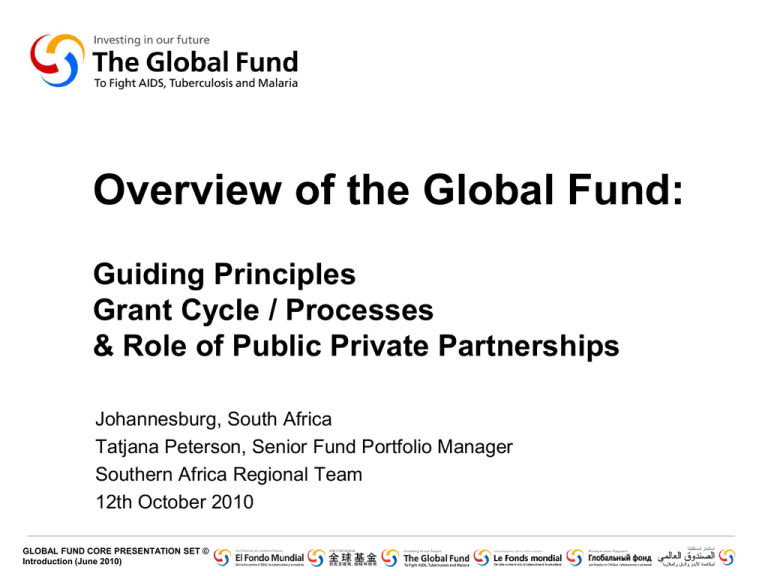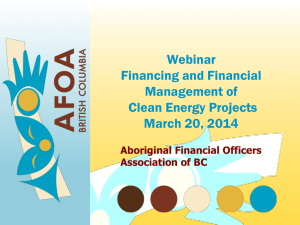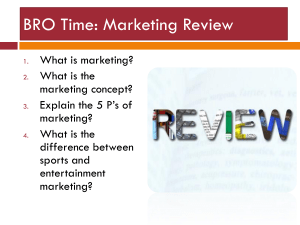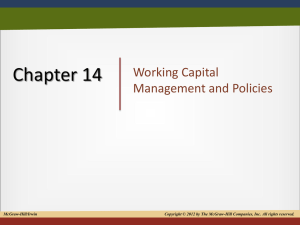Global Fund Core Presentation Set
advertisement

Overview of the Global Fund: Guiding Principles Grant Cycle / Processes & Role of Public Private Partnerships Johannesburg, South Africa Tatjana Peterson, Senior Fund Portfolio Manager Southern Africa Regional Team 12th October 2010 GLOBAL FUND CORE PRESENTATION SET © Introduction (June 2010) Global Fund Guiding Principles 1. Operate as a financial instrument, not an implementing entity 2. Make available and leverage additional financial resources 3. Support programs that reflect national ownership and respect country-led formulation and implementation 4. Operate in a balanced manner in terms of different regions, diseases and interventions 5. Pursue an integrated, balanced approach to prevention, treatment and care 6. Evaluate proposals through independent review processes 7. Establish a simplified, rapid and innovative grant-making process and operate transparently, with accountability. The fund should make use of existing international mechanisms and health plans. 8. Focus on performance by linking resources to the achievement of clear, measurable and sustainable results. GLOBAL FUND CORE PRESENTATION SET © Overview of the Global Fund (June 2010) Global Fund: Key Milestones - G8 endorsed new AIDS, TB and malaria targets 2000 2001 - Global Fund created at first Board meeting - Round 1 proposals approved at second Board meeting 2002 - African leaders committed to greater response in Abuja - UN General Assembly endorses need for a “global fund” GLOBAL FUND CORE PRESENTATION SET © Overview of the Global Fund (June 2010) 2003 2004 - 1st voluntary Replenishment - 2nd Replenishment: US$ 9.7 billion pledged - Round 8 approved (US$ 3.1 billion – largest so far) 2005 2006 2007 - Round 2 and 3 proposals approved - Annual Rounds for proposals started - First Partnership Forum (Bangkok) 2008 2009 2010 - Twentieth Board meeting: Round 9 approved Cumulative disbursements reach US$ 10 billion -- 3rd Replenishment US$ 11.7 billion pledged Partnership Approach to Governance A diverse partnership reflected in the Board and Country Coordinating Mechanisms • Donors • Recipient Countries ● Private Sector • Private Foundations GLOBAL FUND CORE PRESENTATION SET © Overview of the Global Fund (June 2010) Public Sector (Governments and Agencies) Private Sector Civil Society Technical Agencies and Partnerships ● NGOs from Global North ● NGOs from Global South ● Communities living with, and affected by, the diseases ● WHO ● UNAIDS ● World Bank ● UNITAID ● RBM ● Stop TB Partnership… How money flows to people GLOBAL FUND CORE PRESENTATION SET © Overview of the Global Fund (June 2010) Grant Lifecycle Management Process GLOBAL FUND CORE PRESENTATION SET © Overview of the Global Fund (June 2010) Global Fund Approved Proposals By Disease Component (Rounds 1 – 9) Malaria 28% HIV/AIDS 56% TB 16% Source: Global Fund Grant Data GLOBAL FUND CORE PRESENTATION SET © Financing and Additionality (August 2010) OP/140709/2 Global Fund Approved Proposals By Region (Rounds 1-9) Middle East & North Affrica 6% East Asia & Pacific 14% Eastern Europe & Central Asia 7% Sub-Saharan Africa 57% Latin America & the Caribbean 7% South Asia 9% Source: Global Fund Grant Data GLOBAL FUND CORE PRESENTATION SET © Financing and Additionality (August 2010) OP/140709/2 Global Fund Financing Contribution to International Financing for HIV/AIDS, 2008 The Global Fund contributed 19% of the overall international HIV/AIDS financing in 2008 Source: UNAIDS/Kaiser Foundation Report, 2009 Global Fund 19% Other Agencies (PEPFAR, World Bank, other Bilaterals, UN Agencies) 81% GLOBAL FUND CORE PRESENTATION SET © Financing and Additionality (August 2010) OP/140709/2 Global Fund Financing Contribution to International Financing for TB, 2009 Budgets The Global Fund accounted for 64% of overall international financing for tuberculosis in 2009 Source: WHO Stop TB Department, 2009 GLOBAL FUND CORE PRESENTATION SET © Financing and Additionality (August 2010) OP/140709/2 Global Fund Financing Contribution to International Financing for Malaria, 2008 The Global Fund contributed 57% of the overall international financing for malaria in 2008 Source: Roll Back Malaria, 2010 Other DAC and multilaterals 13% US (PMI, USAID) 24% Global Fund 57% The World Bank 6% GLOBAL FUND CORE PRESENTATION SET © Financing and Additionality (August 2010) OP/140709/2 Global Fund Financing HIV/AIDS Grants: Coverage by Country (Rounds 1-9) 140 countries Source: Global Fund Grant Data 0 US$ 10.8 billion (Approved Grant Amount) 2,500 5,000 Kilometers US$ 17.4 billion (Total Lifetime Budget) ´ GLOBAL FUND CORE PRESENTATION SET © Financing and Additionality (August 2010) OP/140709/2 Global Fund Financing Tuberculosis Grants: Coverage by Country (Rounds 1-9) 112 countries Source: Global Fund Grant Data 0 2,500 US$ 3.2 billion (Approved Grant Amount) 5,000 Kilometers GLOBAL FUND CORE PRESENTATION SET © Financing and Additionality (August 2010) US$ 5.8 billion (Total Lifetime Budget) ´ OP/140709/2 Global Fund Financing Malaria Grants: Coverage by Country (Rounds 1-9) 83 countries Source: Global Fund Grant Data 0 US$ 5.3 billion (Approved Grant Amount) 2,500 5,000 Kilometers US$ 8.3 billion (Total Lifetime Budget) ´ GLOBAL FUND CORE PRESENTATION SET © Financing and Additionality (August 2010) OP/140709/2 Global Fund Financing by Principal Recipient Type (mid-2010) Source: Global Fund Grant Data GLOBAL FUND CORE PRESENTATION SET © Financing and Additionality (August 2010) Additionality of Global Fund Financing • Global Fund should “make available and leverage additional financial resources” • NOT displace other donor or government commitments • Global Level: – Total official development assistance (ODA) disbursements for all three diseases have been increasing since 2002 – The Global Fund has provided substantial funding to fight AIDS, tuberculosis and malaria • Country Level: – Government expenditure on health as well as on TB and malaria control in Global Fund top disbursing countries has been mostly increasing or levelling GLOBAL FUND CORE PRESENTATION SET © Financing and Additionality (August 2010) Key Performance Indicators (KPIs): Framework Overview ■ The Key Performance Indicator (KPI) framework is designed to assess the core functions of the Global Fund Secretariat, grant performance and the effectiveness of Global Fund financing, and the impact achieved on the three epidemics. CORPORATE Performance Impact System Effects SECRETARIAT Performance Grant Performance Operational performance - Portfolio management - Administrative effectiveness - Resource mobilization GLOBAL FUND CORE PRESENTATION SET © Key Performance Indicators (June 2010) Ultimate measure of the success in fighting the 3 diseases and reaching the MDGs Assesses the development of sustainable (health) systems in Global Fund recipient countries Cornerstone of performance-based funding; measures grant results against their targets Measures the performance of the core functions of the Global Fund, including the Secretariat Performance-Based Funding (PBF) Performance-based funding (PBF) ensures that funding decisions are based on a transparent assessment of results against time-bound targets. PBF lies at the heart of the Global Fund’s operating model: Raise it “In making its funding decisions, the Global Fund will … focus on performance by linking resources to the achievement of clear, measurable and sustainable results”. Framework Document of the Global Fund (October 2003) GLOBAL FUND CORE PRESENTATION SET © Performance-Based Funding (June 2010) PBF at the Global Fund The Global Fund’s model of performance-based funding was developed to: 1. Link funding to the achievement of country-owned objectives and targets 5. Invest in measurement systems and promote the use of evidence for decision-making 2. Ensure that money is spent on delivering services for people in need 6. Provide a tool for grant oversight and monitoring within countries and by the Global Fund Secretariat 3. Provide incentives for grantees to focus on programmatic results and timely implementation 4. Encourage learning to strengthen capacities and improve program implementation GLOBAL FUND CORE PRESENTATION SET © Performance-Based Funding (June 2010) 7. Free-up committed resources from non-performing grants for re-allocation to programs where results can be achieved Grant Performance by Principal Recipient (end 2009) Latest disbursement ratings for the 378 active grants evaluated as at 1 st January 2010. GLOBAL FUND CORE PRESENTATION SET © Performance-Based Funding (June 2010) A1 Exceeds expectations A2 Meets expectations B1 Adequate B2 Inadequate but potential demonstrated C Unacceptable Source: Global Fund Grant Data Four Roles of the Private Sector Contributor of Resources Supporter of Advocacy & Governance Implementation Partner Provider of Goods & Services GLOBAL FUND CORE PRESENTATION SET © Financing and Additionality (August 2010) BG/290607/2






